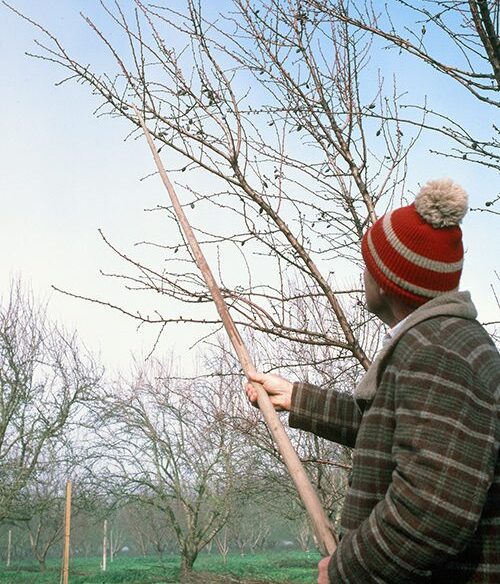
Mummy nuts have been identified as the link for overwintering navel orangeworm (NOW), and growers are strongly encouraged to practice winter sanitation not only as a foundation for any NOW control program, but also for the emerging invasive pest, the Carpophilus beetle.
NOW damage is also associated with aflatoxin, so along with the direct damage NOW causes to the kernel, the damage opens the door to fungal infections and contaminants, particularly to the fungi Aspergillus spp. and the aflatoxin contaminant it produces.
This is critically important when it comes to export markets like the European Union and Japan that have limitations for aflatoxin contamination. The European Union is one of the biggest importers of California almonds. They have tight regulations and a low threshold for aflatoxin levels.
Benefits of Orchard Sanitation
Sudan Gyawaly, integrated pest management advisor for Butte, Glenn, Yuba/Sutter, Colusa and Tehama counties, said, “Winter sanitation is considered the foundation for navel orangeworm management, which is a key pest of this crop. So, if you are wanting to decrease your next year’s NOW damage, sanitation is the key,” he said.
Sanitation has two major benefits. First, NOW overwinters in the mummy nuts, so removing the mummy nuts and destroying them kills the overwintering insects, which directly reduces the number of insects overwintering in those nuts.
Secondly, when mummy nuts are removed, it also removes those nuts that would serve as a shelter, breeding site and food source for NOW until the new crop is available.
Mark Cavallero, owner of Cavallero Farms in Madera, Calif., does winter sanitation on his almonds, and he agrees there are multiple benefits to winter sanitation.
“The biggest benefit would be when you leave almonds on the tree throughout winter, you’re literally creating homes for navel orangeworms. And it’s a place for them to hide, and they have an abundance of food to sit there and and snack while they’re waiting for harvest time, for the new crop to be ready.”
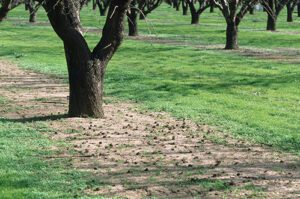
Carpophilus Beetle vs NOW
The Carpophilus beetle uses those mummy nuts just like the NOW does. “We have two insects we are trying to manage with sanitation,” Gyawaly said.
The Carpophilus beetle is a new pest in California. Farm advisors and researchers are still collecting information in terms of its biology, ecology and how it utilizes the mummy nuts. But with few chemical controls available, winter sanitation has been identified as a critical component in stopping its development.
There are some differences between these two pests. While both utilize the mommy nuts, the Carpophilus beetle tends to prefer the mummy nuts that are on the orchard floor, whereas NOW prefers the mummy nuts that are on the tree. This makes it even more critical to destroy the mummy nuts that are on the orchard floor.
The other difference is the beetles may continue breeding on the mummy nuts and complete multiple generations building up more population before the new crop is available, Gyawaly said.
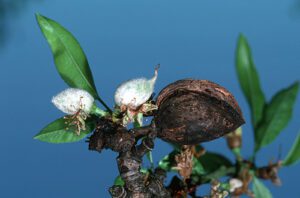
Equipment for Sanitation
Besides mowing to remove the mummy nuts from the orchard floor, there is also tillage equipment available that incorporates them into the soil.
Kat Coombes, manager of Tillage Management Inc. in Tulare, Calif., said they have tillage equipment that incorporates the mummy nuts into the soil, and the benefit of that is, underground they are most exposed to moisture.
“The purpose of our equipment is to till the ground and incorporate all of the residue and the nuts on the surface into the soil,” Coombes said. “Some people will still mow. No one really knows what the best way is to get the most shattering on the nuts.”
Getting the mummy nuts below the surface of the soil allows the microbes and the worms to work on them. “There’s a much higher chance that they’ll be broken down,” Coombes said.
“We’ve been making optimizer equipment in general for over 20 years, but we only developed our orchard line around 2017-18,” Coombes said.
Orchard Disk is a towed five-row implement that hooks to a tractor. “In comparison to other tillage equipment, we are typically the heaviest and the most expensive, mainly because of the amount of steel in it. But the idea is that you’re saving time by only going through in one pass compared to three or four passes with any other equipment,” Coombes said, which means less labor, less fuel, less wear and tear on the equipment.
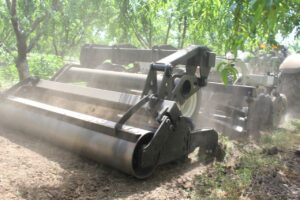
Stick Tights
Stick tights can make mummy removal more difficult, according to Mohammad Yaghmour, orchard systems advisor in Kern County. “The more stick tights in general, the harder the nuts will come off the tree.”
“Some varieties stick more on the tree than the others,” Yaghmour continued, but sometimes there are other problems that create stick tights. “For example, hull rot disease may cause stick tights, so those nuts may also harbor navel orangeworm, and they are hard to get off of the tree.”
Cavallero farmed Butte/Padre almonds, but he’s switched to the Independence variety. “Independence loves to stick, and then finding that window to harvest where they’re not going to stick is tricky, and I feel like every single year it changes. Padres as well also love to stick,” he said.
“One thing I do for my Independence is I usually go through with a pole crew right after they shake the almonds and shake all the trees by hand with these large fiberglass poles, which then come wintertime usually I don’t have very many mummies, if any, because I was able to get them all off during harvest. At this point in the industry today, every pound counts,” Cavallero said.
For the most part, the sticktights are still viable nuts, Cavallero continued. “Even if they aren’t, they have to come off either way, and they’ll get cleaned out during processing, so you might as well get them off now,” Cavallero said.
“The way I see it, if there are enough pounds out there to justify the cost of the crew, to knock them off by hand usually there are more than enough nuts out there to do that. Sometimes it’s not, and then you can go out there during winter sanitation alone. But running those winter sanitation machines is definitely not cheap either, so you might as well try to get them all off during harvest and if you can get any money for them, do it that way,” Cavallero said.
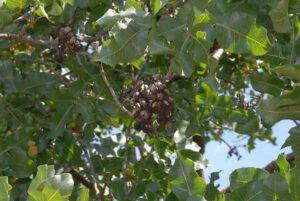
Mummy Nut Removal
According to the Almond Board of California (ABC) winter sanitation is the cornerstone of NOW management. The removal and destruction of mummy nuts prevents overwintering of NOW. This pest can travel to other almond orchards, so winter sanitation is important for your crop and your neighbors.
ABC suggests growers follow these guidelines, which vary by growing region:
1. Before January 15, and preferably earlier: Count the mummy nuts and examine 20 trees per block. If an average of two or more mummy nuts per tree (and even lower in the southern San Joaquin Valley) are found on or before January 15, get out the shaker or poling sticks and remove mummies in the entire block.
2. Before February 1: Remove mummy nuts from trees before bud swell, typically before February 1, by mechanically shaking the tree or hand poling, or both.
3. Before March 1: Blow or sweep fallen mummy nuts to the row centers and destroy them by flail mowing, especially where ground cover is not present or in years with dry winters. This timing is critical as mid-March is when the NOW flights begin.
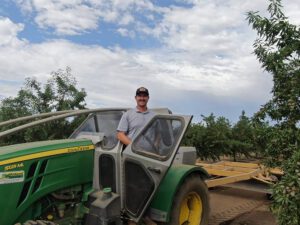
“Just shaking the mummy nuts and leaving them on the ground isn’t really enough,” Yaghmour said. “We need to blow them and mow them to really get the effect of winter sanitation. It’s important to try to destroy the nuts.”
Gyawaly agreed that the mummy nuts should be blown from the crotches of the trees, swept into the middle of the row and mowed. If the nuts are only shaken from the tree, some population will survive in the nuts left on the ground. This makes it important to destroy them once they are on the ground, he said.
Most growers will shake the mummy nuts, sweep and mow them. Some will rototill them back into the ground. This provides organic matter back into the topsoil and preventing the moths or worms a place to reproduce, so basically eliminating risk, Cavallero said.
“It looks a lot cleaner,” he continued, “and I think too the more almonds you leave on the tree, the less you’re going to produce that next year.
“And mummies sometimes are bad enough in some fields where it can be an issue as far as quality, but you’re also just leaving nuts that are no good out there,” Cavallero said.
“In almond, I have seen the growers wait until they get a couple of rains so the nuts absorb some moisture,” Gyawaly said, adding this makes it easier to remove the mummy nuts from the trees, but wait too long and the ground could become saturated, and growers may not be able to get into the orchard.
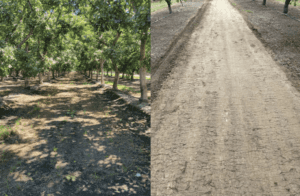
Some growers will do test shakes to see how well the mummy nuts are coming off before they proceed, Yaghmour said.
“You want to do it before the bud swell right,” Cavallero said. “The middle of January to February if you haven’t done it yet, you really won’t have an opportunity to.
“And fighting the elements is the biggest one, and you have to remember most medium to small size operations do not have their own harvest equipment. So, scheduling that is a nightmare, especially with rain,” Cavallero said, adding finding the time and people to do the shaking is difficult along with battling the weather.
“Most of the larger operations have their own equipment, so weather is their only dilemma, vs smaller growers that have weather and scheduling issues with harvesters,” Cavallero said.
“With the Carpophilus beetle, winter sanitation is even more critical,” Gyawaly said, to remove these nuts from the orchard floor because they can survive in even a small piece of nut.
With two insects that can survive in the mummy nuts in almonds, it’s even more critical to practice winter sanitation, Gyawaly said, adding sanitation will definitely keep the population low on the Carpophilus beetle.
Orchard sanitation is the best control for these pests for growers. “It’s very important for controlling Carpophilus beetle and navel orangeworm,” Gyawaly said.
The bottom line: winter sanitation is important for both pests, and it is the key to all control approaches.















